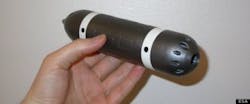A collaborative team of researchers and scientists suggest that a miniature submarine—equipped with thrusters, a CMOS video camera, sonar, on-board software, and a series of other instruments and sensors—will be able to dive into the depths below the icy crust of Europa, a moon of Jupiter, to search for alien life.
The researchers, from NASA’s Jet Propulsion Laboratory (JPL) in California and Uppsala University in Sweden, initially developed a concept for a miniature submarine that could strike a balance between cost and capability for a robotic mission to search for alien life in the ocean beneath Jupiter’s moon Europa’s crust.
But Jonas Jonsson, an original member of the Swedish team and current engineer with Stinger Ghaffarian Technologies Inc. at NASA's Ames Research Center took the project a step further and refined the sub concept by building and testing parts of it for his Ph.D. thesis. While the project requires further development, the technology isn’t all that far off, he says.
“What I think is exciting with this is to be able to explore previously inaccessible areas, to explore where no "man" has explored before," Jonas told the Huffington Post. “I don’t think there any technological breakthroughs required. There exist possible solutions for the technological barriers; however, further developments and optimizations are required for such a mission to succeed."
The sub, named “Deeper Access, Deeper Understanding” would employ eight small thrusters that would allow it to move underwater. It would use a PC-53X5 CMOS video camera from SuperCircuits behind a port glass at the front of the sub, which when activated, would send live video signal back ashore through the optic fiber, according to the research paper from the Ångström Space Technology Centre at Uppsala University. The sub would also employ sonar imaging, an electronic tongue for chemical sampling, and a conductivity-temperature-depth sensor.
Interest in Jupiter’s Europa moon may stem from the Voyager 2 mission in 1972, in which images and data collected hinted at the existence of a liquid water ocean under its top layer of ice, according to the article. The European Space Agency believes that by the year 2030, it will be able to send missions to Jupiter that may carry these robotic exploration subs, according to the Guardian.
View the Uppsala University research paper.
Also check out:
Student designs camera for space
Multispectral imaging captures views of Mars
Share your vision-related news by contacting James Carroll, Senior Web Editor, Vision Systems Design
To receive news like this in your inbox, click here.
About the Author

James Carroll
Former VSD Editor James Carroll joined the team 2013. Carroll covered machine vision and imaging from numerous angles, including application stories, industry news, market updates, and new products. In addition to writing and editing articles, Carroll managed the Innovators Awards program and webcasts.
